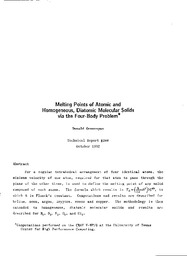
ATTENTION: The works hosted here are being migrated to a new repository that will consolidate resources, improve discoverability, and better show UTA's research impact on the global community. We will update authors as the migration progresses. Please see MavMatrix for more information.
Show simple item record
| dc.contributor.author | Greenspan, Donald | en |
| dc.date.accessioned | 2010-06-02T20:57:57Z | en |
| dc.date.available | 2010-06-02T20:57:57Z | en |
| dc.date.issued | 1992-10 | en |
| dc.identifier.uri | http://hdl.handle.net/10106/2262 | en |
| dc.description.abstract | **Please note that the full text is embargoed** ABSTRACT: For a regular tetrahedral arrangement of four identical atoms, the minimum velocity of one atom, required for that atom to pass through the plane of the other three, is used to define the melting point of any solid composed of such atoms. The formula which results is [see pdf for notation], in which h is Planck's constant. Computations and results are described for helium, neon, argon, krypton, xenon and copper. The methodology is then extended to homogeneous, diatomic molecular solids and results are described for H2, D2, N2, 02, and C12. | en |
| dc.language.iso | en_US | en |
| dc.publisher | University of Texas at Arlington | en |
| dc.relation.ispartofseries | Technical Report;288 | en |
| dc.subject | Melting point | en |
| dc.subject | Planck's constant | en |
| dc.subject | Four-Body Problem | en |
| dc.subject | Computer methodolgy | en |
| dc.subject | Molecular solid | en |
| dc.subject.lcsh | Mathematics Research | en |
| dc.title | Melting Points of Atomic and Homogeneous, Diatomic Molecular Solids Via the Four-Body Problem | en |
| dc.type | Technical Report | en |
| dc.publisher.department | Department of Mathematics | en |
Files in this item
- Name:
- MathTechReport288.pdf
- Size:
- 410.5Kb
- Format:
- PDF
- Description:
- PDF
This item appears in the following Collection(s)
Show simple item record


